West Bengal: Difference between revisions
GoingBatty (talk | contribs) Typo fixing, typos fixed: muslims → Muslims using AWB |
No edit summary |
||
| Line 50: | Line 50: | ||
While West Bengal has made economic gains recently, it still remains one of the most [[Poverty|poorest]] states in India because of high political instability, bad governance and skewed economic policy of the [[State governments in India|state government]].<ref name="TimesofIndia.com">{{cite web | title= Political violence revisits Bengal | url= http://timesofindia.indiatimes.com/India/Political-violence-revisits-Bengal/articleshow/4637878.cms | publisher = Times of India | format = cms | accessdate= Jun 10, 2009 }}</ref><ref name="webcache">[http://econ-www.mit.edu/files/2490 Strategy for Economic Reform in West Bengal]</ref><ref name="TheTelegraph01">http://www.telegraphindia.com/1100713/jsp/frontpage/story_12677609.jsp Minister’s statement that schemes were not ‘properly’ implemented coincides with debate in CPM.</ref><ref name="TheTelegraph02">http://timesofindia.indiatimes.com/India/8-Indian-states-have-more-poor-than-26-poorest-African-nations/articleshow/6158960.cms 8 Indian states have more poor than 26 poorest African nations.</ref> Through out its political and cultural history the state has witnessed strikes,<ref name="Planningcommission.nic.in">{{cite web | title= Opposition's bandh against price rise hits life in West Bengal, Kerala, UP | url= http://www.hindustantimes.com/rssfeed/india/Strike-hits-life-in-West-Bengal-Kerala-Uttar-Pradesh/Article1-536207.aspx | publisher = Hindustan Times | format = aspx | accessdate= 1 October 2005 }}</ref><ref name="sify.com">{{cite web | title= Business in West Bengal affected ahead of Tuesday strike | url= http://sify.com/finance/business-in-west-bengal-affected-ahead-of-tuesday-strike-news-default-ke0sabdcibh.html | publisher = sify finance | accessdate= Jun 10, 2009 }}</ref> a low [[Human Development Index]] level,<ref name="PlanningCommision">{{cite web | title= West Bengal Human Development Index Report | url= http://hdr.undp.org/en/reports/nationalreports/asiathepacific/india/India_West%20Bengal_2004_en.pdf | publisher = The Telegraph | accessdate= October 5, 2008 }}</ref><ref name="IGIDR">{{cite web | title= Convergence of Human Development across Indian States | url= http://www.igidr.ac.in/pdf/publication/PP-062-22.pdf | publisher = Hiranmoy Roy and Kaushik Bhattacharjee | accessdate= October 5, 2008 }}</ref> abysmal medical treatment or healthcare services,<ref name="plunkettresearch">[http://ccs.in/ccsindia/downloads/intern-papers-08/Waiting-for-Healthcare-A-survey-of-a-public-hospital-in-Kolkata-Mansi.pdf A Survey of Public Hospital in Kolkata], by Mansi Shah, June 2010.</ref><ref name="Health">[http://www.wbhealth.gov.in/Externally_Aided_Projects/HSDI-DFID%20Programme%20Memorandum.pdf West Bengal: Health Systems Development Initiative], by Government of West Bengal |
While West Bengal has made economic gains recently, it still remains one of the most [[Poverty|poorest]] states in India because of high political instability, bad governance and skewed economic policy of the [[State governments in India|state government]].<ref name="TimesofIndia.com">{{cite web | title= Political violence revisits Bengal | url= http://timesofindia.indiatimes.com/India/Political-violence-revisits-Bengal/articleshow/4637878.cms | publisher = Times of India | format = cms | accessdate= Jun 10, 2009 }}</ref><ref name="webcache">[http://econ-www.mit.edu/files/2490 Strategy for Economic Reform in West Bengal]</ref><ref name="TheTelegraph01">http://www.telegraphindia.com/1100713/jsp/frontpage/story_12677609.jsp Minister’s statement that schemes were not ‘properly’ implemented coincides with debate in CPM.</ref><ref name="TheTelegraph02">http://timesofindia.indiatimes.com/India/8-Indian-states-have-more-poor-than-26-poorest-African-nations/articleshow/6158960.cms 8 Indian states have more poor than 26 poorest African nations.</ref> Through out its political and cultural history the state has witnessed strikes,<ref name="Planningcommission.nic.in">{{cite web | title= Opposition's bandh against price rise hits life in West Bengal, Kerala, UP | url= http://www.hindustantimes.com/rssfeed/india/Strike-hits-life-in-West-Bengal-Kerala-Uttar-Pradesh/Article1-536207.aspx | publisher = Hindustan Times | format = aspx | accessdate= 1 October 2005 }}</ref><ref name="sify.com">{{cite web | title= Business in West Bengal affected ahead of Tuesday strike | url= http://sify.com/finance/business-in-west-bengal-affected-ahead-of-tuesday-strike-news-default-ke0sabdcibh.html | publisher = sify finance | accessdate= Jun 10, 2009 }}</ref> a low [[Human Development Index]] level,<ref name="PlanningCommision">{{cite web | title= West Bengal Human Development Index Report | url= http://hdr.undp.org/en/reports/nationalreports/asiathepacific/india/India_West%20Bengal_2004_en.pdf | publisher = The Telegraph | accessdate= October 5, 2008 }}</ref><ref name="IGIDR">{{cite web | title= Convergence of Human Development across Indian States | url= http://www.igidr.ac.in/pdf/publication/PP-062-22.pdf | publisher = Hiranmoy Roy and Kaushik Bhattacharjee | accessdate= October 5, 2008 }}</ref> abysmal medical treatment or healthcare services,<ref name="plunkettresearch">[http://ccs.in/ccsindia/downloads/intern-papers-08/Waiting-for-Healthcare-A-survey-of-a-public-hospital-in-Kolkata-Mansi.pdf A Survey of Public Hospital in Kolkata], by Mansi Shah, June 2010.</ref><ref name="Health">[http://www.wbhealth.gov.in/Externally_Aided_Projects/HSDI-DFID%20Programme%20Memorandum.pdf West Bengal: Health Systems Development Initiative], by Government of West Bengal |
||
Government of India DFID, UK, 15 January 2005.</ref> tremendous lack of social development,<ref name="HindustanTimes">{{cite web | title= Impact of Social Sector Development in West Bengal - Midnapore and Birbhum districts | url= http://planningcommission.nic.in/reports/sereport/ser/wbm_indx.htm | publisher = Planning Commission of India }}</ref> poor infrastructure,<ref name="telegraphindia.com">{{cite web | title= The people of Bengal created the darkness that envelops them | url= http://www.telegraphindia.com/1081005/jsp/opinion/story_9927371.jsp | publisher = The Telegraph | accessdate= October 5, 2008 }}</ref><ref name="tt1">[http://www.telegraphindia.com/1100613/jsp/business/story_12560050.jsp Bengal will have to improve its infrastructure, policy reform and governance before the ADB considers extending any poverty alleviation loan, June 2010.]</ref> excessive [[corruption]] and [[Political violence|violence]].<ref name="EconomicTimes">{{cite web | title= West Bengal political violence continues | url= http://economictimes.indiatimes.com/news/politics/nation/West-Bengal-political-violence-continues/articleshow/4871906.cms | publisher = Economic Times | format = aspx | accessdate= 1 October 2005 }}</ref><ref name="Guardian.co.uk">{{cite web | title= Six killed as farmers and communists clash in West Bengal | url= http://www.guardian.co.uk/world/2007/nov/12/india.randeepramesh | publisher = Guardian | format = aspx | accessdate= 1 October 2005 }}</ref> According to leading [[Economist]]s West Bengal is by far the least industrialized and underdeveloped state as compared to other metropolitan states, where industrialization and economic development is relatively very high.<ref name="WCMS">{{cite web | title= The Evolution of Industrial Relations in West Bengal | url= http://www.ilo.org/wcmsp5/groups/public/---asia/---ro-bangkok/---sro-new_delhi/documents/publication/wcms_123342.pdf | publisher = Dr. Ratna Sen | format = PDF | accessdate= 2009 }}</ref><ref name="econ.lse.ac.uk">{{cite web | title= Beyond Nandigram: Industrialisation in West Bengal | url= http://econ.lse.ac.uk/staff/mghatak/westbeng2.pdf |accessdate= 2009 }}</ref><ref name="wbidc.com">{{cite web | title= Issues Regarding Industrialisation in West Bengal | url= http://www.wbidc.com/images/pdf/Issues_Regarding_Indu_WB.pdf | publisher = | format = PDF | accessdate= 2009}}</ref> |
Government of India DFID, UK, 15 January 2005.</ref> tremendous lack of social development,<ref name="HindustanTimes">{{cite web | title= Impact of Social Sector Development in West Bengal - Midnapore and Birbhum districts | url= http://planningcommission.nic.in/reports/sereport/ser/wbm_indx.htm | publisher = Planning Commission of India }}</ref> poor infrastructure,<ref name="telegraphindia.com">{{cite web | title= The people of Bengal created the darkness that envelops them | url= http://www.telegraphindia.com/1081005/jsp/opinion/story_9927371.jsp | publisher = The Telegraph | accessdate= October 5, 2008 }}</ref><ref name="tt1">[http://www.telegraphindia.com/1100613/jsp/business/story_12560050.jsp Bengal will have to improve its infrastructure, policy reform and governance before the ADB considers extending any poverty alleviation loan, June 2010.]</ref> excessive [[corruption]] and [[Political violence|violence]].<ref name="EconomicTimes">{{cite web | title= West Bengal political violence continues | url= http://economictimes.indiatimes.com/news/politics/nation/West-Bengal-political-violence-continues/articleshow/4871906.cms | publisher = Economic Times | format = aspx | accessdate= 1 October 2005 }}</ref><ref name="Guardian.co.uk">{{cite web | title= Six killed as farmers and communists clash in West Bengal | url= http://www.guardian.co.uk/world/2007/nov/12/india.randeepramesh | publisher = Guardian | format = aspx | accessdate= 1 October 2005 }}</ref> According to leading [[Economist]]s West Bengal is by far the least industrialized and underdeveloped state as compared to other metropolitan states, where industrialization and economic development is relatively very high.<ref name="WCMS">{{cite web | title= The Evolution of Industrial Relations in West Bengal | url= http://www.ilo.org/wcmsp5/groups/public/---asia/---ro-bangkok/---sro-new_delhi/documents/publication/wcms_123342.pdf | publisher = Dr. Ratna Sen | format = PDF | accessdate= 2009 }}</ref><ref name="econ.lse.ac.uk">{{cite web | title= Beyond Nandigram: Industrialisation in West Bengal | url= http://econ.lse.ac.uk/staff/mghatak/westbeng2.pdf |accessdate= 2009 }}</ref><ref name="wbidc.com">{{cite web | title= Issues Regarding Industrialisation in West Bengal | url= http://www.wbidc.com/images/pdf/Issues_Regarding_Indu_WB.pdf | publisher = | format = PDF | accessdate= 2009}}</ref>. However West Bengal has been one of the few states to distribute land amongst landless agricultural workers. Even today, after 30 years of land distribution in West Bengal, it accounts for more land distributed amongst landless labourers is the Country. |
||
An agriculture-dependent state, West Bengal occupies only 2.7% of the India's land area, though it supports over 7.8% of the Indian population, and is the most densely populated state in India.<ref name=hdrchap1>{{cite web |
An agriculture-dependent state, West Bengal occupies only 2.7% of the India's land area, though it supports over 7.8% of the Indian population, and is the most densely populated state in India.<ref name=hdrchap1>{{cite web |
||
Revision as of 14:46, 28 July 2010
Template:Pp-pending Template:Infobox Indian jurisdiction
West Bengal (Bengali: পশ্চিমবঙ্গ Poshchim Bônggo, IPA: [poʃtʃim bɔŋɡo]) is a state in eastern regions of India and is the nation's fourth most populous.[1] It is also the seventh most populous sub-nationals entity in the world.[1] West Bengal is the third largest contributor to India's GDP.[2] Bangladesh lies on its eastern border. To its northeast lie the states of Assam and Sikkim and the country Bhutan, and to its southwest lies the state of Orissa. To the west it borders the states of Jharkhand and Bihar, and to the northwest, Nepal.
The region that is now West Bengal was where a number of empires and kingdoms were founded during the past two millennia. The British East India Company cemented their hold on the region following the Battle of Plassey in 1757, and the city of Calcutta, now Kolkata, served for many years as the capital of British India. A hotbed of the Indian independence movement through the early 20th century, Bengal was divided in 1947 along religious lines into two separate entities, West Bengal—a state of India, and East Bengal, a part of the new nation of Pakistan which is now Bangladesh . Following India's independence in 1947, West Bengal's economic and political systems were dominated for many decades by Marxism, Naxalite movements and trade unionism.[3][4][5][6][7]
While West Bengal has made economic gains recently, it still remains one of the most poorest states in India because of high political instability, bad governance and skewed economic policy of the state government.[8][9][10][11] Through out its political and cultural history the state has witnessed strikes,[12][13] a low Human Development Index level,[14][15] abysmal medical treatment or healthcare services,[16][17] tremendous lack of social development,[18] poor infrastructure,[19][20] excessive corruption and violence.[21][22] According to leading Economists West Bengal is by far the least industrialized and underdeveloped state as compared to other metropolitan states, where industrialization and economic development is relatively very high.[23][24][25]. However West Bengal has been one of the few states to distribute land amongst landless agricultural workers. Even today, after 30 years of land distribution in West Bengal, it accounts for more land distributed amongst landless labourers is the Country.
An agriculture-dependent state, West Bengal occupies only 2.7% of the India's land area, though it supports over 7.8% of the Indian population, and is the most densely populated state in India.[26] West Bengal has had Communist Party of India (Marxist)-led Left Front rule for three decades, making it the world's longest-running democratically elected communist government.[27][28][29]
History
Remnants of civilisation in the greater Bengal region date back 4,000 years,[30][31] when the region was settled by Dravidian, Tibeto-Burman and Austro-Asiatic peoples. The exact origin of the word Bangla or Bengal is unknown, though it is believed to be derived from the Dravidian-speaking tribe Bang that settled in the area around the year 1000 BC.[32] The kingdom of Magadha was formed in 7th century BC, consisting of the Bihar and Bengal regions. It was one of the four main kingdoms of India at the time of Mahavira and the Buddha, and consisted of several Janapadas.[33] During the rule of Maurya dynasty, the Magadha Empire extended over nearly all of South Asia, including Afghanistan and parts of Persia under Ashoka the Great in the 3rd century BC.
One of the earliest foreign references to Bengal is the mention of a land named Gangaridai by the Greeks around 100 BC. The word is speculated to have come from Gangahrd (Land with the Ganges in its heart) in reference to an area in Bengal.[34] Bengal had overseas trade relations with Java, Sumatra and Siam (modern day Thailand). According to Mahavamsa, Vijaya Singha, a Vanga prince, conquered Lanka (modern day Sri Lanka) in 544 BC and gave the name "Sinhala" to the country. Bengali people migrated to the Malay Archipelago and Siam (in modern Thailand), establishing their own colonies there.
From the 3rd to the 6th centuries AD, the kingdom of Magadha served as the seat of the Gupta Empire. The first recorded independent king of Bengal was Shashanka, reigning around early 7th century.[35] After a period of anarchy, the Buddhist Pala dynasty ruled the region for four hundred years, followed by a shorter reign of the Hindu Sena dynasty. Islam was introduced to Bengal in the twelfth century by Sufi missionaries.Invasion by the Turkish Muslims started in about 1206.The Hindu Bengali kingdoms held on in various parts of south and east bengal till about the 1350s.After that Hindu political power was limited to the area of Koch Bihar in North Bengal and as baronships and vassal chiefdoms in west bengal and western areas of east bengal. Subsequent Muslim conquests helped spread Islam throughout the region.[36] Bakhtiar Khilji, a Turkic general of the Slave dynasty of Delhi Sultanate, defeated Lakshman Sen of the Sena dynasty and conquered large parts of Bengal in about 1206.The process of conquest continued till about the 1350s. Consequently, the region was ruled by dynasties of sultans and feudal lords under the Delhi Sultanate for the next few hundred years. In the sixteenth century, Mughal general Islam Khan conquered Bengal. However, administration by governors appointed by the court of the Mughal Empire gave way to semi-independence of the area under the Nawabs of Murshidabad, who nominally respected the sovereignty of the Mughals in Delhi.
European traders arrived late in the fifteenth century. Their influence grew until the British East India Company gained taxation rights in Bengal subah, or province, following the Battle of Plassey in 1757, when Siraj ud-Daulah, the last independent Nawab, was defeated by the British.[37] The Bengal Presidency was established by 1765, eventually including all British territories north of the Central Provinces (now Madhya Pradesh), from the mouths of the Ganges and the Brahmaputra to the Himalayas and the Punjab. The Bengal famine of 1770 claimed millions of lives.[38] Calcutta was named the capital of British India in 1772. The Bengal Renaissance and Brahmo Samaj socio-cultural reform movements had great impact on the cultural and economic life of Bengal. The failed Indian rebellion of 1857 started near Calcutta and resulted in transfer of authority to the British Crown, administered by the Viceroy of India.[39] Between 1905 and 1911, an abortive attempt was made to divide the province of Bengal into two zones.[40] Bengal suffered from the Great Bengal famine in 1943 that claimed 3 million lives.[41]
Bengal played a major role in the Indian independence movement, in which revolutionary groups such as Anushilan Samiti and Jugantar were dominant. Armed attempts against the British Raj from Bengal reached a climax when Subhash Chandra Bose led the Indian National Army from Southeast Asia against the British. When India gained independence in 1947, Bengal was partitioned along religious lines. The western part went to India (and was named West Bengal) while the eastern part joined Pakistan as a province called East Bengal (later renamed East Pakistan, giving rise to independent Bangladesh in 1971).[42] Both West and East Bengal suffered from large refugee influx during the partition in 1947, leading to the political unrests later on. The partition of Bengal entailed the greatest exodus of people in Human History. Millions of Hindus migrated from East Pakistan to India and thousands of Muslims too went across the borders to East Pakistan. Because of the immigration of the refugees, there occurred the crisis of land and food in West Bengal; and such condition remained in long duration for more than three decades.The politics of West Bengal since the partition in 1947 developed round the nucleus of refugee problem. Both the Rightists and the Leftists in the Politics of West Bengal have not yet become free from the socio-economic conditions created by the partition of Bengal. These conditions as have remained unresolved in some twisted forms have given birth to local socio-economic, political and ethnic movements.[43]
In 1950 the Princely State of Cooch Behar merged with West Bengal after King Jagaddipendra Narayan had signed the Instrument of Accession with India.[44] In 1955, the former French enclave of Chandannagar, which had passed into Indian control after 1950, was integrated into West Bengal; portions of Bihar were subsequently merged with West Bengal.
In the fifties, it was decided by the then Congress Government to shift industries from the state to other parts of the country. The value of freight tax and other taxes were also kept higher for the state by the central Government till the eighties ( see for example this article). This contributed to very few manufacturing industries being set in the state from 1950 to 1969.
During the 1970s and 1980s, severe power shortages, strikes and a violent Marxist-Naxalite movement damaged much of the state's infrastructure, leading to a period of economic stagnation. The Bangladesh Liberation War of 1971 resulted in the influx of millions of refugees to West Bengal, causing significant strains on its infrastructure.[45] The 1974 smallpox epidemic killed thousands. West Bengal politics underwent a major change when the Left Front won the 1977 assembly election, defeating the incumbent Indian National Congress. The Left Front, led by Communist Party of India (Marxist), has governed for the state for the subsequent three decades.[46]
The state's economic recovery gathered momentum after economic reforms in India were introduced in the mid-1990s by the central government, aided by election of a new reformist Chief Minister Buddhadeb Bhattacharya in 2000. As of 2007, armed activists have been organising minor terrorist attacks in some parts of the state,[47][48] while clashes with the administration are taking place at several sensitive places on the issue of industrial land acquisition.[49][50]
Geography and climate

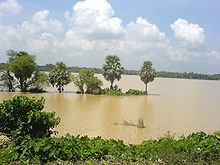
West Bengal is on the eastern bottleneck of India, stretching from the Himalayas in the north to the Bay of Bengal in the south. The state has a total area of 88,752 square kilometres (34,267 sq mi).[51] The Darjeeling Himalayan hill region in the northern extreme of the state belongs to the eastern Himalaya. This region contains Sandakfu (3,636 metres (11,929 ft)*)—the highest peak of the state.[52] The narrow Terai region separates this region from the plains, which in turn transitions into the Ganges delta towards the south. The Rarh region intervenes between the Ganges delta in the east and the western plateau and high lands. A small coastal region is on the extreme south, while the Sundarbans mangrove forests form a remarkable geographical landmark at the Ganges delta.
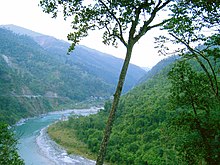
The Ganges is the main river, which divides in West Bengal. One branch enters Bangladesh as the Padma or Pôdda, while the other flows through West Bengal as the Bhagirathi River and Hooghly River. The Teesta, Torsa, Jaldhaka and Mahananda rivers are in the northern hilly region. The western plateau region has rivers such as the Damodar, Ajay and Kangsabati. The Ganges delta and the Sundarbans area have numerous rivers and creeks. Pollution of the Ganges from indiscriminate waste dumped into the river is a major problem.[53] At least nine districts in the state suffer from arsenic contamination of groundwater, and an estimated 8.7 million people drink water containing arsenic above the World Health Organisation recommended limit of 10 µg/L.[54] West Bengal's climate varies from tropical savannah in the southern portions to humid subtropical in the north. The main seasons are summer, rainy season, a short autumn, and winter. While the summer in the delta region is noted for excessive humidity, the western highlands experience a dry summer like northern India, with the highest day temperature ranging from 38 °C (100 °F) to 45 °C (113 °F).[55] At nights, a cool southerly breeze carries moisture from the Bay of Bengal. In early summer brief squalls and thunderstorms known as Kalbaisakhi, or Nor'westers, often occur.[56] Monsoons bring rain to the whole state from June to September. West Bengal receives the Bay of Bengal branch of the Indian ocean monsoon that moves in a northwest direction. Winter (December–January) is mild over the plains with average minimum temperatures of 15 °C (59 °F).[55] A cold and dry northern wind blows in the winter, substantially lowering the humidity level. However, the Darjeeling Himalayan Hill region experiences a harsh winter, with occasional snowfall at places.
Flora and fauna
| Union day | 18 August (Day of accession to India) | |
| State animal | Bengal Tiger | File:A tiger in Pilibhit Tiger Reserve.jpg |
| State bird | White-throated Kingfisher | |
| State tree | Devil Tree |  [57] [57]
|
| State flower | Night-flowering Jasmine |
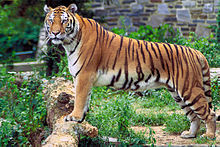


Owing to the varying altitude from the Himalayas to the coastal plains, the flora and fauna of the state is diverse. Forests make up 14% of the geographical area of West Bengal, which is lower than the national average of 23%.[58][59] Protected forests cover 4% of the state area.[60] Part of the world's largest mangrove forest Sundarbans is located in southern West Bengal.[61]
From a phytogeographic viewpoint, the southern part of West Bengal can be divided into two regions: the Gangetic plain and the littoral mangrove forests of the Sundarbans.[62] The alluvial soil of the Gangetic plain compounded with favorable rainfall make this region especially fertile.[62] Much of the vegetation of the western part of the state shares floristic similarities with the plants of the Chota Nagpur plateau in the adjoining state of Jharkhand.[62] The predominant commercial tree species is Shorea robusta, commonly known as Sal. The coastal region of Purba Medinipur exhibits coastal vegetation; the predominant tree is the Casuarina. The most valuable tree from the Sundarbans is the ubiquitous sundri (Heritiera fomes) from which the forest gets its name.[63] Vegetation in northern West Bengal is dictated by elevation and precipitation. For example, the foothills of the Himalayas, the Dooars, are densely wooded with Sal and other trees of the tropical evergreen type.[64] Above 1000 m, the forest type changes to subtropical. In Darjeeling, which is above 1500 m, common trees typifying the temperate forest are oaks, conifers, and rhododendrons.[64]
The Sundarbans are noted for a reserve project conserving Bengal tigers. There are five national parks in the state[65] — Sundarbans National Park, Buxa Tiger Reserve, Gorumara National Park, Neora Valley National Park and Singalila National Park. Wildlife includes the Indian rhinoceros, Indian elephants, deer, bison, leopards, gaur, and crocodiles. The state is also rich in bird life. Migratory birds come to the state during the winter.[60] The high altitude forests like Singalila National Park shelter barking deer, red panda, chinkara, takin, serow, pangolin, minivet and Kalij pheasants. In addition to the Bengal tiger, the Sundarbans host many other endangered species like Gangetic dolphin, river terrapin, estuarine crocodile etc.[66] The mangrove forest also acts as a natural fish nursery, supporting coastal fishes along the Bay of Bengal.[66]
Government and politics
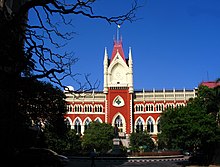

West Bengal is governed through a parliamentary system of representative democracy, a feature the state shares with other Indian states. Universal suffrage is granted to residents. There are two branches of government. The legislature, the West Bengal Legislative Assembly, consists of elected members and special office bearers such as the Speaker and Deputy Speaker, that are elected by the members. Assembly meetings are presided over by the Speaker or the Deputy Speaker in the Speaker's absence. The judiciary is composed of the Calcutta High Court and a system of lower courts. Executive authority is vested in the Council of Ministers headed by the Chief Minister, although the titular head of government is the Governor. The Governor is the head of state appointed by the President of India. The leader of the party or coalition with a majority in the Legislative Assembly is appointed as the Chief Minister by the Governor, and the Council of Ministers are appointed by the Governor on the advice of the Chief Minister. The Council of Ministers reports to the Legislative Assembly. The Assembly is unicameral with 295 Members of the Legislative Assembly, or MLAs,[67][68] including one nominated from the Anglo-Indian community. Terms of office run for 5 years, unless the Assembly is dissolved prior to the completion of the term. Auxiliary authorities known as panchayats, for which local body elections are regularly held, govern local affairs. The state contributes 42 seats to Lok Sabha and 16 seats to Rajya Sabha of the Indian Parliament.[69]
The main players in the regional politics are the Left Front alliance (led by the Communist Party of India (Marxist) or CPI(M)), the All India Trinamool Congress, the Indian National Congress, and other major/minor parties. Following the West Bengal State Assembly Election in 2006, the Left Front coalition under Buddhadeb Bhattacharya of the CPI(M) was elected to power(getting 235 seats in the legislature). West Bengal has been ruled by the Left Front for the past 30 years, making it the world's longest-running democratically elected communist government.[46][70][71]
The people of the state are very politically aware and the Left-Right polarisation is sharp. This is also reflected in the participation in the state and national-level elections. Most of the media channels in the state (and more generally in India) have their political bias and basic information is often manipulated by vested interests as suggested by this article. In fact any concept of a balanced view can be arrived at by only directly getting the views of different political parties.
Subdivisions

The 19 districts of West Bengal are as listed below with the numbers corresponding to those in the image at left.[72]
Each district is governed by a district collector or district magistrate, appointed either by the Indian Administrative Service or the West Bengal Civil Service.[73] Each district is subdivided into Sub-Divisions, governed by a sub-divisional magistrate, and again into Blocks. Blocks consists of panchayats (village councils) and town municipalities.[72]
The capital and largest city of the state is Kolkata — the third-largest urban agglomeration[74] and the fourth-largest city[75] in India. Siliguri is an economically important Metropolitan City, strategically located in the northeastern Siliguri Corridor (Chicken's Neck) of India. Asansol, Durgapur are the other Metropolitan cities in the western industrial belt.[76] Other major cities and towns in West Bengal are Howrah, Raniganj, Haldia, Jalpaiguri, Kharagpur, Burdwan, Darjeeling, Midnapore, Tamluk, Malda and Cooch Behar.[76]
Economy

| Gross State Domestic Product at Current Prices (93–94 Base)[77]
figures in crores of Indian Rupees | |
| Year | Gross State Domestic Product |
|---|---|
| 1999–2000 | 135,182 |
| 2000–2001 | 143,532 |
| 2001–2002 | 157,136 |
| 2002–2003 | 168,047 |
| 2003–2004 | 189,099 |
| 2004–2005 | 208,578 |
| 2005–2006 | 236,044 |
Agriculture is the leading occupation in West Bengal. Rice is the state's principal food crop. Other food crops are pulses, oil seeds, wheat, tobacco, sugarcane and potatoes. Jute is the main cash crop of the region. Tea is also produced commercially; the region is well known for Darjeeling and other high quality teas.[78] However, the service sector is the largest contributor to the gross domestic product of the state, contributing 51% of the state domestic product compared to 27% from agriculture and 22% from industry.[79] State industries are localized in the Kolkata region and the mineral-rich western highlands. The Durgapur–Asansol colliery belt is home to a number of major steel plants.[78] Manufacturing industries playing an important economic role are engineering products, electronics, electrical equipment, cables, steel, leather, textiles, jewellery, frigates, automobiles, railway coaches, and wagons.

A significant part of the state is economically backward, namely, large parts of six northern districts of Cooch Behar, Darjeeling, Jalpaiguri, Malda, North Dinajpur and South Dinajpur; three western districts of Purulia, Bankura, Birbhum; and the Sundarbans area.[26] Years after independence, West Bengal was still dependent on the central government for meeting its demands for food; food production remained stagnant and the Indian green revolution bypassed the state. However, there has been a significant spurt in food production since the 1980s, and the state now has a surplus of grains.[26] The state's share of total industrial output in India was 9.8% in 1980–81, declining to 5% by 1997–98. However, the service sector has grown at a rate higher than the national rate.[26]
West Bengal has the third largest economy (2003–2004) in India, with a net state domestic product of US$ 21.5 billion.[79] During 2001–2002, the state's average SDP was more than 7.8% — outperforming the National GDP Growth.[80] The state has promoted foreign direct investment, which has mostly come in the software and electronics fields;[79] Kolkata is becoming a major hub for the Information technology (IT) industry. Owing to the boom in Kolkata's and the overall state's economy, West Bengal is now the third fastest growing economy in the country.[81] However, the rapid industrialisation process has given rise to debate over land acquisition for industry in this agrarian state.[82] NASSCOM–Gartner ranks West Bengal power infrastructure the best in the country.[83] West Bengals state domestic product (SDP) grew in 2004 with 12.7 % and in 2005 with 11.0 % .[84] "Taking a cue from China, West Bengals’s Chief Minister Buddhadeb Bhattacharya has pushed through an ambitious economic reform program with an approach more capitalist than communist."[85]
Transport


The total length of surface road in West Bengal is over 92,023 km (57,180 mi);[86] national highways comprise 2,377 km (1,477 mi)[87] and state highways 2,393 km (1,487 mi). The road density of the state is 103.69 km per 100 km² (166.92 mi per 100 sq mi), higher than the national average of 74.7 km per 100 km² (120 mi per 100 sq mi).[88] Average speed on state highways varies between 40–50 km/h (25–31 mi/h); in villages and towns, speeds are as low as 20–25 km/h (12–16 mi/h) due to the substandard quality of road constructions and low maintenance. Total railway length is 3,825 km (2,377 mi).[89] Kolkata is the headquarters of two divisions of the Indian Railways—Eastern Railway and South Eastern Railway.[90] The Northeast Frontier Railway (NFR) plies in the northern parts of the state. The Kolkata metro is the country's first underground railway.[91] The Darjeeling Himalayan Railway, part of NFR, is a UNESCO World Heritage Site.[92]

The state's only international airport is Netaji Subhash Chandra Bose International Airport at Dum Dum, Kolkata. Bagdogra airport near Siliguri is another significant airport in the state and recently it has been upgraded to an international airport. Kolkata is a major river-port in eastern India. The Kolkata Port Trust manages both the Kolkata docks and the Haldia docks.[93] There is passenger service to Port Blair on the Andaman and Nicobar Islands and cargo ship service to ports in India and abroad, operated by the Shipping Corporation of India. Ferry is a principal mode of transport in the southern part of the state, especially in the Sundarbans area. Kolkata is the only city in India to have trams as a mode of transport and these are operated by the Calcutta Tramways Company.[94]
Several government-owned organisations operate substandard bus services in the state, including the Calcutta State Transport Corporation, the North Bengal State Transport Corporation, the South Bengal State Transport Corporation, the West Bengal Surface Transport Corporation, and the Calcutta Tramways Company, thus leading to mismanagement. There are also private bus companies. The railway system is a nationalised service without any private investment. Hired forms of transport include metered taxis and auto rickshaws which often ply specific routes in cities. In most of the state, cycle rickshaws, and in Kolkata, hand-pulled rickshaws, are also used for short-distance travel.
Demographics

The vast majority of the 80,221,171 people of West Bengal[96] are Bengalis.[97] The Bihari minority is scattered throughout the state and communities of Sherpas and ethnic Tibetans can be found in regions bordering Sikkim. Darjeeling district has a large number of Gurkha people of Nepalese origin. West Bengal is home to indigenous tribal Adivasis such as Santals, Kol, Koch-Rajbongshi and Toto tribe.
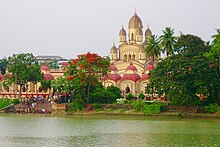
The official language is Bengali and English.[98][99] Hindi is also commonly used. Nepali is spoken primarily in the Darjeeling district. Languages such as Rajbongshi, Santali and Ho are used in some parts of the state. Urdu is used primarily in Central Kolkata.
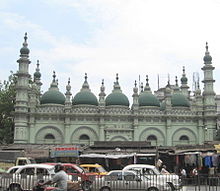
As of 2001 , Hinduism is the principal religion at 72.5% of the total population, while Muslims comprise 25.2% of the total population , being the second-largest community as also the largest minority group; Sikhism, Christianity and other religions make up the remainder.[95] West Bengal has a population density of Template:PD km2 to sq mi making it the most densely populated state in India.[100] The state contributes 7.81% of India's population.[101] The state's 1991–2001 growth rate of 17.84% is lower than the national rate of 21.34%.[96] The gender ratio is 934 females per 1000 males.[96]
The literacy rate is 69.22%.[96] Data of 1995–1999 showed the life expectancy in the state was 63.4 years, higher than the national value of 61.7 years.[102] About 72% of people live in rural areas. The proportion of people living below the poverty line in 1999–2000 was 31.85%.[26] Scheduled Castes and Tribes form 28.6% and 5.8% of the population respectively in rural areas, and 19.9% and 1.5% respectively in urban areas.[26]
The crime rate in the state in 2004 was 82.6 per 100,000, which was half of the national average.[103] This is the fourth-lowest crime rate among the 32 states and union territories of India.[104] However, the state reported the highest rate of Special and Local Laws (SLL) crimes.[105] In reported crimes against women, the state showed a crime rate of 7.1 compared to the national rate of 14.1.[104] West Bengal was the first Indian state to constitute a Human Rights Commission of its own.[104]
Culture
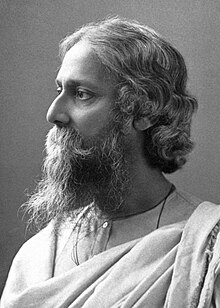
The Bengali language boasts a rich literary heritage, shared with neighbouring Bangladesh. West Bengal has a long tradition in folk literature, evidenced by the Charyapada, Mangalkavya, Shreekrishna Kirtana, Thakurmar Jhuli, and stories related to Gopal Bhar. In the nineteenth and twentieth century, Bengali literature was modernized in the works of authors such as Bankim Chandra Chattopadhyay, Michael Madhusudan Dutt, Rabindranath Tagore, Kazi Nazrul Islam, Sharat Chandra Chattopadhyay, Jibananda Das and Manik Bandyopadhyay.
The Baul tradition is a unique heritage of Bengali folk music, which has also been influenced by regional music traditions.[106] Other folk music forms include Gombhira and Bhawaiya. Folk music in West Bengal is often accompanied by the ektara, a one-stringed instrument. West Bengal also has an heritage in North Indian classical music. "Rabindrasangeet", songs composed and set into tune by Rabindranath Tagore and "Nazrul geeti" (by Kazi Nazrul Islam) are popular. Also prominent are other musical forms like Dwijendralal, Atulprasad and Rajanikanta's songs, and "adhunik" or modern music from films and other composers. From the early 1990s, there has been an emergence and popularisation of new genres of music, including fusions of Baul and Jazz by several Bangla bands, as well as the emergence of what has been called Jeebonmukhi Gaan (a modern genre based on realism). Bengali dance forms draw from folk traditions, especially those of the tribal groups, as well as the broader Indian dance traditions. Chau dance of Purulia is a rare form of mask dance.[107]
Mainstream Hindi films are popular, as are films from the Bengali cinema industry, dubbed "Tollywood". Tollygunj in Kolkata is the location of Bengali movie studios and the name "Tollywood" (similar to Hollywood and Bollywood) is derived from that name. The Bengali film industry is also known for art films or Indy films. Its long tradition of filmmaking has produced acclaimed directors like Satyajit Ray, Mrinal Sen, Tapan Sinha and Ritwik Ghatak. Contemporary directors include Buddhadev Dasgupta, Goutam Ghose, Aparna Sen and Rituparno Ghosh.
Bengal had been the harbinger of modernism in fine arts. Abanindranath Tagore, called the father of Modern Indian Art had started the Bengal School of Art which was to create styles of art outside the European realist tradition which was taught in art colleges under the colonial administration of the British Government. The movement had many adherents like Gaganendranath Tagore, Ramkinkar Baij, Jamini Roy and Rabindranath Tagore. After Indian Independence, important groups like the Calcutta Group and the Society of Contemporary Artists were formed in bengal which dominated the art scene in India.
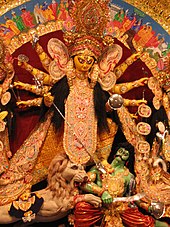
Food
Rice and fish are traditional favourite foods, leading to a saying in Bengali, machhe bhate bangali, that translates as "fish and rice make a Bengali".[108] Bengal's vast repertoire of fish-based dishes includes hilsa preparations, a favorite among Bengalis. Bengalis make distinctive sweetmeats from milk products, including Rôshogolla, Chômchôm, Kalojam and several kinds of sondesh. Pitha and patishapta are specialties of winter season. Sweets like coconut-naru, til-naru, moa, payesh, etc. are prepared during the festival of Lakshmi puja. Popular street food includes Aloor Chop, Beguni, Kati roll, and phuchka.[109][110] Panta bhat (rice soaked overnight in water)with onion & green chili is a traditional dish consumed in rural areas. Common spices found in a Bengali kitchen are cumin, ajmoda (radhuni), bay leaf, mustard, ginger, green chillies, turmeric, etc. People of erstwhile East Bengal use a lot of ajmoda, coriander leaves, tamarind, coconut and mustard in their cooking; while those aboriginally from West Bengal use a lot of sugar, garam masala and red chilli powder. Vegetarian dishes are mostly without onion and garlic.

Costumes
Bengali women commonly wear the shaŗi , often distinctly designed according to local cultural customs. In urban areas, many women and men wear Western attire. Among men, western dressing has greater acceptance. Men also wear traditional costumes such as the panjabi with dhuti , often on cultural occasions.
Festivals
Durga Puja in October is the most popular festival in the West Bengal.[111] Poila Baishakh (the Bengali New Year), Rathayatra, Dolyatra or Basanta-Utsab, Nobanno, Poush Parbon (festival of Poush), Kali Puja, SaraswatiPuja, LaxmiPuja, Christmas, Eid ul-Fitr, Eid ul-Adhaand Muhharam are other major festivals.[112] Buddha Purnima, which marks the birth of Gautama Buddha, is one of the most important Hindu/Buddhist festivals while Christmas, called Bôŗodin (Great day) in Bengali is celebrated by the minority Christian population. Poush mela is a popular festival of Shantiniketan, taking place in winter.[112] West Bengal has been home to several famous religious teachers, including Sri Chaitanya, Sri Ramakrishna, Swami Vivekananda, A. C. Bhaktivedanta Swami Prabhupada and Paramahansa Yogananda.
Education

West Bengal schools are run by the state government or by private organisations, including religious institutions. Instruction is mainly in English or Bengali, though Urdu are also used, especially in Central Kolkata. The secondary schools are affiliated with the Council for the Indian School Certificate Examinations (CISCE), the Central Board for Secondary Education (CBSE), the National Institute of Open School (NIOS) or the West Bengal Board of Secondary Education. Under the 10+2+3 plan, after completing secondary school, students typically enroll for 2 years in a junior college, also known as pre-university, or in schools with a higher secondary facility affiliated with the West Bengal Council of Higher Secondary Education or any central board. Students choose from one of three streams, namely, liberal arts, commerce or science. Upon completing the required coursework, students may enroll in general or professional degree programs.
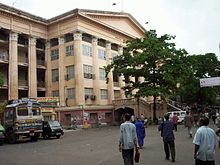
West Bengal has eighteen universities.[113][114] The University of Calcutta, one of the oldest and largest public universities in India, has more than 200 affiliated colleges.[115] The Bengal Engineering & Science University and Jadavpur University are prestigious technical universities.[116] Visva-Bharati University at Santiniketan is a central university and an institution of national importance.[117] The state has several higher education institutes of national importance including the Indian Statistical Institute, Indian Institute of Technology Kharagpur (the first IIT of the country), West Bengal National University of Juridical Sciences, Indian Institute of Foreign Trade, the Indian Institute of Management Calcutta (the first management institute in India of its kind) and the National Institute of Technology, Durgapur (formerly Regional Engineering College, Durgapur). After 2003 the state govt supported the creation of West Bengal University of Technology, West Bengal State University and Gour Banga University. Besides these, the state also has Vidyasagar University and North Bengal University at nooks and corner of the state and also an Indian Institute of Science Education and Research, Kolkata.
Media
West Bengal had 505 published newspapers in 2005,[118] of which 389 were in Bengali.[118] Ananda Bazar Patrika, published from Kolkata with 1,234,122 daily copies, has the largest circulation for a single-edition, regional language newspaper in India.[118] Other major Bengali newspapers are Bartaman, Sangbad Pratidin, Aajkaal, Jago Bangla, Uttarbanga Sambad and Ganashakti. Major English language newspapers which are published and sold in large numbers are The Times of India, Hindustan Times, The Hindu, The Indian Express, The Statesman, The Telegraph and Asian Age. Some prominent financial dailies like The Economic Times, Financial Express, Business Line and Business Standard are widely circulated. Vernacular newspapers such as those in Hindi, Gujarati, Oriya, Urdu, Punjabi and Nepali are also read by a select readership.
Doordarshan is the state-owned television broadcaster. Multi system operators provide a mix of Bengali, Nepali, Hindi, English and international channels via cable. Bengali 24-hour television news channels include STAR Ananda, Tara Newz, Kolkata TV, 24 Ghanta, Ne Bangla, News Time, Channel 10 and R-Plus.[119][120] All India Radio is a public radio station.[120] Private FM stations are available only in cities like Kolkata, Siliguri and Asansol.[120] Vodafone, Airtel, BSNL, Reliance Communications, Uninor, Aircel, MTS India, Tata Indicom, Idea Cellular and Tata DoCoMo are available cellular phone operators. Broadband internet is available in select towns and cities and is provided by the state-run BSNL and by other private companies. Dial-up access is provided throughout the state by BSNL and other providers.
Sports

Cricket and football (soccer) are popular sports in the state. Kolkata is one of the major centers for football in India[121] and houses top national clubs such as East Bengal, Mohun Bagan and Mohammedan Sporting Club.[122] Indian sports such as Kho Kho and Kabaddi are also played. Calcutta Polo Club is considered as the oldest polo club of the world,[123] and the Royal Calcutta Golf Club is the oldest of its kind outside Great Britain.[124]
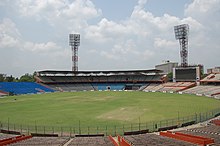
West Bengal has several large stadiums—The Eden Gardens is one of only two 100,000-seat cricket amphitheaters in the world.[125] Salt Lake Stadium—a multi-use stadium—is the world's second highest-capacity football stadium.[126][127] Calcutta Cricket and Football Club is the second-oldest cricket club in the world.[128] National and international sports events are also held in Durgapur, Siliguri and Kharagpur.[129] Notable sports persons from West Bengal include former Indian national cricket captain Sourav Ganguly, Olympic tennis bronze medallist Leander Paes, and chess grand master Dibyendu Barua. Other major sporting icons over the years include famous football players such as Chuni Goswami, PK Banerjee and Sailen Manna as well as swimmer Mihir Sen and athlete Jyotirmoyee Sikdar (winner of gold medals at the Asian Games).[130]
See also
Notes
- ^ a b "India: Administrative Divisions (population and area)". Census of India. Retrieved 2009-04-17.
- ^ Gross Domestic Product by prices as of 28 February, 2008.
- ^ "Why India's Stalinists oppose the US nuclear deal" (aspx). WSWS. Retrieved March 27, 2010.
- ^ "Fresh gunfight between police, Naxals in West Bengal" (aspx). DNA. Retrieved March 27, 2010.
- ^ "A slaughter reveals the inadequacy of India's counterinsurgency effort" (aspx). The Economist. Retrieved Apr 8th 2010.
{{cite news}}: Check date values in:|accessdate=(help) - ^ "While the debate goes on whether trade unions must be allowed in the IT sector, the CITU forms one in West Bengal". FrontLine. Retrieved Dec. 01, 2006.
{{cite web}}: Check date values in:|accessdate=(help) - ^ "Waking up too late". The Statesman. Retrieved 11 April 2010.
- ^ "Political violence revisits Bengal" (cms). Times of India. Retrieved Jun 10, 2009.
- ^ Strategy for Economic Reform in West Bengal
- ^ http://www.telegraphindia.com/1100713/jsp/frontpage/story_12677609.jsp Minister’s statement that schemes were not ‘properly’ implemented coincides with debate in CPM.
- ^ http://timesofindia.indiatimes.com/India/8-Indian-states-have-more-poor-than-26-poorest-African-nations/articleshow/6158960.cms 8 Indian states have more poor than 26 poorest African nations.
- ^ "Opposition's bandh against price rise hits life in West Bengal, Kerala, UP" (aspx). Hindustan Times. Retrieved 1 October 2005.
- ^ "Business in West Bengal affected ahead of Tuesday strike". sify finance. Retrieved Jun 10, 2009.
- ^ "West Bengal Human Development Index Report" (PDF). The Telegraph. Retrieved October 5, 2008.
- ^ "Convergence of Human Development across Indian States" (PDF). Hiranmoy Roy and Kaushik Bhattacharjee. Retrieved October 5, 2008.
- ^ A Survey of Public Hospital in Kolkata, by Mansi Shah, June 2010.
- ^ West Bengal: Health Systems Development Initiative, by Government of West Bengal Government of India DFID, UK, 15 January 2005.
- ^ "Impact of Social Sector Development in West Bengal - Midnapore and Birbhum districts". Planning Commission of India.
- ^ "The people of Bengal created the darkness that envelops them". The Telegraph. Retrieved October 5, 2008.
- ^ Bengal will have to improve its infrastructure, policy reform and governance before the ADB considers extending any poverty alleviation loan, June 2010.
- ^ "West Bengal political violence continues" (aspx). Economic Times. Retrieved 1 October 2005.
- ^ "Six killed as farmers and communists clash in West Bengal" (aspx). Guardian. Retrieved 1 October 2005.
- ^ "The Evolution of Industrial Relations in West Bengal" (PDF). Dr. Ratna Sen. Retrieved 2009.
{{cite web}}: Check date values in:|accessdate=(help) - ^ "Beyond Nandigram: Industrialisation in West Bengal" (PDF). Retrieved 2009.
{{cite web}}: Check date values in:|accessdate=(help) - ^ "Issues Regarding Industrialisation in West Bengal" (PDF). Retrieved 2009.
{{cite web}}: Check date values in:|accessdate=(help) - ^ a b c d e f "Introduction and Human Development Indices for West Bengal" (PDF). West Bengal Human Development Report 2004. Development and Planning Department, Government of West Bengal. 2004. pp. pp4–6. Archived from the original (PDF) on 2006-11-08. Retrieved 2006-08-26.
{{cite web}}:|pages=has extra text (help); External link in|work=|month=ignored (help) - ^ "CPI(M) architect of misrule in Bengal". Government of India (2001). IBNLive. Retrieved April 15, 2009.
- ^ "The question is not who will win but what lies behind the Left Front's impending electoral victory, its 15th in succession". Government of India (2001). The Hindu. Retrieved April 15, 2009.
- ^ "CPI dominana in West Bengal". Rudrangshu Mukherjee. Retrieved Jun 10, 2009.
- ^ "History of Bangladesh". Bangladesh Student Association. Retrieved 2006-10-26.
- ^ "4000-year old settlement unearthed in Bangladesh". Xinhua. 2006-March.
{{cite news}}: Check date values in:|date=(help) - ^ James Heitzman and Robert L. Worden, ed. (1989). "Early History, 1000 B.C.-A.D. 1202". Bangladesh: A country study. Library of Congress.
- ^ Sultana, Sabiha. "Settlement in Bengal (Early Period)". Banglapedia. Asiatic Society of Bangladesh. Retrieved 2007-03-04.
- ^ Chowdhury, AM. "Gangaridai". Banglapedia. Asiatic Society of Bangladesh. Retrieved 2006-09-08.
- ^ "Shashanka". Banglapedia. Asiatic Society of Bangladesh. Retrieved 2006-10-26.
- ^ "Islam (in Bengal)". Banglapedia. Asiatic Society of Bangladesh. Retrieved 2006-10-26.
- ^ Chaudhury, S; Mohsin, KM. "Sirajuddaula". Banglapedia. Asiatic Society of Bangladesh. Retrieved 2006-10-26.
- ^ Fiske, John. "The Famine of 1770 in Bengal". The Unseen World, and other essays. University of Adelaide Library Electronic Texts Collection. Retrieved 2006-10-26.
- ^ (Baxter 1997, pp. 30–32)
- ^ (Baxter 1997, pp. 39–40)
- ^ Sen, Amartya (1973). Poverty and Famines. Oxford University Press. ISBN 0-19-828463-2.
- ^ Harun-or-Rashid. "Partition of Bengal, 1947". Banglapedia. Asiatic Society of Bangladesh. Retrieved 2006-10-26.
- ^ Dr. Sailen Debnath, 'West Bengal in Doldrums'ISBN 978-81-86860-34-2; & Dr. Sailen Debnath ed. Social and Political Tensions In North Bengal since 1947, ISBN 81-86860-23-1
- ^ Dr. Sailen Debnath,ed. Social and Political Tensions In North Bengal since 1947, ISBN 81-86860-23-1.
- ^ (Bennett & Hindle 1996, pp. 63–70)
- ^ a b Biswas, Soutik (2006-04-16). "Calcutta's colourless campaign". BBC. Retrieved 2006-08-26.
- ^ Ghosh Roy, Paramasish (2005-07-22). "Maoist on Rise in West Bengal". VOA Bangla. Voice of America. Retrieved 2006-09-11.
- ^ "Maoist Communist Centre (MCC)". Left-wing Extremist group. South Asia Terrorism Portal. Retrieved 2006-09-11.
- ^ "Several hurt in Singur clash". rediff News. Rediff.com India Limited. 28 January 2007. Retrieved 2007-03-15.
- ^ "Red-hand Buddha: 14 killed in Nandigram re-entry bid". The Telegraph. 15 March 2007. Retrieved 2007-03-15.
- ^ "Statistical Facts about India". www.indianmirror.com. Retrieved 2006-10-26.
- ^ "National Himalayan Sandakphu-Gurdum Trekking Expedition: 2006". Youth Hostels Association of India: West Bengal State Branch. Retrieved 2006-10-26.
- ^ "Alarming rise in bacterial percentage in Ganga waters". The Hindu Business Line. 4 August 2006. Retrieved 2006-10-29.
- ^ "Groundwater Arsenic Contamination Status in West Bengal". Groundwater Arsenic Contamination in West Bengal – India (17 Years Study). School of Environmental Studies, Jadavpur University. Retrieved 2006-10-29.
- ^ a b "Climate". West Bengal: Land. Suni System (P) Ltd. Retrieved 2006-09-05.
- ^ "kal Baisakhi". Glossary of Meteorology. American Meteorological Society. Retrieved 2006-09-05.
- ^ a b "State Trees and Flowers of India". Flowersofindia.net. Retrieved 2010-07-18.
- ^ "Flora and Fauna". calcuttayellowpages.com (P) Ltd. Retrieved 2006-08-25.
- ^ "Environmental Issues". West Bengal Human Development Report 2004 (PDF). Development and Planning Department, Government of West Bengal. 2004 [2004]. pp. 180–182. ISBN 81-7955-030-3. Retrieved 2006-08-26.
{{cite book}}: External link in|chapterurl=|chapterurl=ignored (|chapter-url=suggested) (help); Unknown parameter|month=ignored (help) - ^ a b "West Bengal: General Information". India in Business. Federation of Indian Chambers of Commerce and Industry. Retrieved 2006-08-25.
- ^ Islam, Sadiq (29 June 2001). "World's largest mangrove forest under threat". CNN Student Bureau. Cable News Network. Retrieved 2006-10-31.
- ^ a b c Mukherji, S.J. (2000). College Botany Vol. III: (chapter on Phytogeography). Calcutta: New Central Book Agency. pp. 345–365.
- ^ Snedaker, Samuel (2006-08-29). "Notes on the Sundarbans". Retrieved 2006-10-02.
- ^ a b "Natural vegetation". West Bengal. Suni System (P) Ltd. Retrieved 2006-10-31.
- ^ "West Bengal". Directory of Wildlife Protected Areas in India. Wildlife Institute of India. Retrieved 2006-10-26.
- ^ a b "Problems of Specific Regions". West Bengal Human Development Report 2004 (PDF). Development and Planning Department, Government of West Bengal. 2004 [2004]. pp. 200–203. ISBN 81-7955-030-3. Retrieved 2006-08-26.
{{cite book}}: External link in|chapterurl=|chapterurl=ignored (|chapter-url=suggested) (help); Unknown parameter|month=ignored (help) - ^ "West Bengal Legislative Assembly". Legislative Bodies in India. National Informatics Centre. Retrieved 2006-10-28.
- ^ "Election Database". Election Commission of India. Archived from the original on 2006-08-18. Retrieved 2006-08-26.
- ^ "West Bengal". India Together. Civil Society Information Exchange Pvt. Ltd. Retrieved 2006-08-26.
- ^ "The CPI(M) has always used violence to achieve its goals". India Together. The Telegraph. Retrieved 2006-08-26.
- ^ "West Bengal: Next time, the volcano". India Together. The Times of India. Retrieved Jun 21, 2009.
- ^ a b "Directory of District, Sub division, Panchayat Samiti/ Block and Gram Panchayats in West Bengal, March 2008". West Bengal. National Informatics Centre, India. 2008-03-19. Retrieved 2008-11-19.
- ^ "Section 2 of West Bengal Panchayat Act, 1973". Department of Panchayat and Rural Department, West Bengal. Retrieved 2008-12-09.
- ^ "India: metropolitan areas". World Gazetteer. Retrieved 2006-10-26.
- ^ "India: largest cities and towns and statistics of their population". World Gazetteer. Retrieved 2006-10-26.
- ^ a b David Christiana (2007-09-01). "Arsenic Mitigation in West Bengal, India: New Hope for Millions" (PDF). Southwest Hydrology. p. 32. Retrieved 2008-12-20.
- ^ "Gross State Domestic Product at Current Prices". National Accounts Division: Press release & Statements. Ministry of Statistics and Programme Implementation, Government of India. Retrieved 2008-03-29.
{{cite web}}: External link in|publisher= - ^ a b "Economy". West Bengal. Suni System (P) Ltd. Retrieved 2006-09-07.
- ^ a b c "The State Economy" (PDF). Indian States Economy and Business: West Bengal. India Brand Equity Foundation, Confederation of Indian Industry. p. 9. Retrieved 2006-09-07.
- ^ "Basic Information". About West Bengal. West Bengal Industrial Development Corporation. Archived from the original on 2006-11-28. Retrieved 2006-09-07.
- ^ "Consul General Henry V. Jardine to The Indo-American Chamber of Commerce, 19 October 2005". Retrieved 2006-04-11.
- ^ Ray Choudhury, R (27 October 2006). "A new dawn beckons West Bengal". The Hindu Business Line. Retrieved 2006-10-29.
- ^ "West Bengal Industrial Development Corporation Ltd" (PDF). India @ Hannover Messe 2006. Engineering Export Promotion Council (EEPC), India. p. 303. Retrieved 2006-09-07.
- ^ "Statement: Gross state domestic product at current prices". Directorate of Economics & Statistics of respective State Governments, and for All-India. Retrieved 2007-09-02.
- ^ "India / West Bengal: World's Longest –Running Democratically Elected Marxist Government | News Analysis | English". .voanews.com. 2006-09-04. Retrieved 2010-07-18.
- ^ "West Bengal: Infrastructure". Public Private Partnerships in India. Dept of Economic Affairs, Ministry of Finance, Government of India. Retrieved 2006-10-27.
- ^ "List of State-wise National Hoghways in the Country". National Highways. Department of Road Transport and Highways; Ministry of Shipping, Road Transport and Highways; Government of India. Archived from the original on 2007-01-20. Retrieved 2006-10-27.
- ^ Chattopadhyay, Suhrid Sankar (2006). "Remarkable Growth". Frontline. 23 (02). Chennai, India: The Hindu. Retrieved 2008-03-31.
{{cite journal}}: Invalid|ref=harv(help); Unknown parameter|month=ignored (help) - ^ "West Bengal". Indian States-A Profile. Indian Investment Centre, Government of India. Retrieved 2006-09-01.
- ^ "Geography : Railway Zones". IRFCA.org. Indian Railways Fan Club. Retrieved 2007-08-31.
- ^ "About Kolkata Metro". Kolkata Metro. Retrieved 2007-09-01.
- ^ "Mountain Railways of India". UNESCO World Heritage Centre. Retrieved 2006-04-30.
- ^ "Salient Physical Features". Kolkata Port Trust. Kolkata Port Trust, India. Retrieved 2007-06-09.
- ^ "Intra-city train travel". reaching India. Times Internet Limited. Retrieved 2007-08-31.
- ^ a b "Data on Religion". Census of India (2001). Office of the Registrar General & Census Commissioner, India. Archived from the original on 2007-08-12. Retrieved 2006-08-26.
- ^ a b c d "Provisional Population Totals: West Bengal". Census of India, 2001. Office of the Registrar General & Census Commissioner, India. Archived from the original on 2007-08-07. Retrieved 2006-08-26.
- ^ "West Bengal". Infobengal.com. Retrieved 2006-09-13.
- ^ "Languages of India". Retrieved 2009-09-02.
- ^ "Languages in Descending Order of Strength - India, States and Union Territories - 1991 Census" (PDF). Census Data Online. Office of the Registrar General, India. p. 1. Archived from the original on 2007-06-14. Retrieved 2006-11-19.
{{cite web}}: Cite has empty unknown parameter:|month=(help) - ^ "Press Release – Provisional Population Results – Census of India 2001". Office of the Registrar General & Census Commissioner, India. 26 March 2001. Archived from the original on 2007-08-08. Retrieved 2006-08-26.
- ^ Population of West Bengal (80,221,171) is 7.81% of India's population (1,027,015,247)
- ^ "An Indian life: Life expectancy in our nation". India Together. Civil Society Information Exchange Pvt. Ltd. Retrieved 2006-08-26.
- ^ National Crime Records Bureau (2004). "Crimes in Mega Cities". Crime in India-2004. Ministry of Home Affairs. p. 158.
{{cite book}}:|access-date=requires|url=(help);|format=requires|url=(help); External link in|chapterurl=|chapterurl=ignored (|chapter-url=suggested) (help) - ^ a b c "Human Security" (PDF). West Bengal Human Development Report 2004. Development and Planning Department, Government of West Bengal. 2004. pp. pp167–172. Archived from the original (PDF) on 2006-11-08. Retrieved 2006-08-26.
{{cite web}}:|pages=has extra text (help); External link in|work=|month=ignored (help) - ^ National Crime Records Bureau (2004). "General Crime Statistics Snapshots 2004". Crime in India-2004. Ministry of Home Affairs. p. 1.
{{cite book}}:|access-date=requires|url=(help);|format=requires|url=(help); External link in|chapterurl=|chapterurl=ignored (|chapter-url=suggested) (help) - ^ "The Bauls of Bengal". Folk Music. BengalOnline. Retrieved 2006-10-26.
- ^ "Chau: The Rare Mask Dances". Dances of India. Boloji.com. Retrieved 2006-10-22.
- ^ Gertjan de Graaf, Abdul Latif. "Development of freshwater fish farming and poverty alleviation: A case study from Bangladesh" (PDF). Aqua KE Government. Retrieved 2006-10-22.
- ^ Saha, S (18 January 2006). "Resurrected, the kathi roll – Face-off resolved, Nizam's set to open with food court". The Telegraph (Kolkata). Retrieved 2006-10-26.
- ^ "Mobile food stalls". Bangalinet.com. Retrieved 2006-10-26.
- ^ "Durga Puja". Festivals of Bengal. West Bengal Tourism, Government of West Bengal. Retrieved 2006-10-28.
- ^ a b "List of festivals of West Bengal". Festivalsofindia.in.
- ^ "UGC recognised Universities in West Bengal with NAAC accreditation status". Education Observer. Retrieved 2006-10-26.
- ^ "West Bengal University of Health Sciences". West Bengal University of Health Sciences. Retrieved 2006-10-26.
- ^ "List of Affiliated Colleges". University of Calcutta. Retrieved 2008-03-29.
- ^ Mitra, P (31 August 2005). "Waning interest". Careergraph. The Telegraph. Retrieved 2006-10-26.
- ^ "Visva-Bharati: Facts and Figures at a Glance". Visva-Bharati Computer Centre. Retrieved 2007-03-31.
- ^ a b c "General Review". Registrar of Newspapers for India. Retrieved 2008-03-29.
- ^ "Bengali News Channel took 5 months to reach no.1 position". News Center. Retrieved Sep 07, 2006.
{{cite web}}: Check date values in:|accessdate=(help) - ^ a b c "CALCUTTA : Television, Radio Channels". Calcutta Web. Retrieved Sep 07, 2006.
{{cite web}}: Check date values in:|accessdate=(help) - ^ Prabhakaran, Shaji (18 January 2003). "Football in India – A Fact File". LongLiveSoccer.com. Retrieved 2006-10-26.
- ^ "Indian Football Clubs". Iloveindia.com. Retrieved 2006-10-26.
- ^ "History of Polo". Hurlingham Polo Association. Retrieved 2007-08-30.
- ^ "Royal Calcutta Golf Club". Encyclopaedia Britannica. Retrieved 2007-08-30.
- ^ "India – Eden Gardens (Kolkata)". Cricket Web. Retrieved 2006-10-26.
- ^ "100 000+ Stadiums". World Stadiums. Retrieved 2006-10-26.
- ^ "The Asian Football Stadiums (30.000+ capacity)". Gunther Lades. Retrieved 2006-10-26.
- ^ Raju, Mukherji (14 March 2005). "Seven Years? Head Start". The Telegraph. Retrieved 2006-10-26.
- ^ "Sports & Adventure". West Bengal Tourism. Retrieved 2006-10-22.
- ^ "Famous Indian Football Players". Iloveindia.com. Retrieved 2006-10-26.
References
- Baxter, C (1997). Bangladesh, From a Nation to a State. Westview Press. p. 0813336325. ISBN 185984121X.
{{cite book}}: Invalid|ref=harv(help) - Bennett, A; Hindle, J (1996). London Review of Books: An Anthology. Verso. pp. 63–70. ISBN 185984121X.
{{cite book}}: Invalid|ref=harv(help) - Roy, A; Alsayyad, N (2004). Urban Informality: Transnational Perspectives from the Middle East, Latin America and South Asia. Lexington Books. ISBN 0739107410.
{{cite book}}: Invalid|ref=harv(help) - West Bengal Human Development Report 2004. Development and Planning Department, Government of West Bengal. 2004. ISBN 8179550303.
{{cite book}}: External link in|title=|ref=harv(help) - Impact of Social Sector Development in West Bengal. Planning Commission, Government of India. 2009. ISBN 45174569037.
{{cite book}}: Check|isbn=value: length (help); External link in|title=|ref=harv(help) - Klass, L; Morton, S (1996). Community Structure and industrialization in West Bengal. University Press of America Inc. ISBN 0-7618-0420-X.
{{cite book}}: Invalid|ref=harv(help) - Sunny, C (1999). "Poverty and social development in west bengal" (PDF). India Rural Development Report, NIRD. Retrieved 1999.
{{cite journal}}: Check date values in:|accessdate=(help); Invalid|ref=harv(help) - KPMG India, V (2001-12-10). "Sustainable economic development in West Bengal – A Perspective" (PDF). Confederation of Indian Industry (CII). Retrieved 2007.
{{cite journal}}: Check date values in:|accessdate=(help); Invalid|ref=harv(help) - Amrita Basu, V. (1997). Two Faces of Protest: Contrasting Modes of Women's Activism in India. University of California Press ltd. ISBN 0-520-06506--9. Retrieved 2009-06-16.
- Jasodhara Bagchi, Sarmistha Dutta Gupta, V. (2000). The changing status of women in West Bengal, 1970-2000: the challenge ahead. Saga Publication India Pvt Ltd. ISBN 0-7619-3242-9. Retrieved 2010-06-16.
- Magnus Öberg, Kaare Strom, V. (2008). Resources, governance and civil conflict. Routledge. ISBN 0-415-41679-X. Retrieved 2004-06-16.
{{cite book}}: Check|isbn=value: checksum (help) - Atul Kohli, I. (1987). The State and Poverty in India. Cambridge University Press. ISBN 978-0-521-37876-5. Retrieved 2007-06-16.
- Marvin, Davis (1983) [1983]. Rank and rivalry: the politics of inequality in rural West Bengal. Cambridge: Cambridge University Press. ISBN 052124657.
{{cite book}}: Check|isbn=value: length (help) - Richard Maxwell Eaton, The rise of Islam and the Bengal frontier, 1204-1760, 1993, University of California Press, California, California,1993, ISBN 0-520-08077-7.
- Ross Mallick. (1955). Development Policy of a Communist Government: West Bengal Since 1977, Cambridge University Press, Cambridge (Reprinted 2008) ISBN 978-0-521-43292-4.
- Jasodhara Bagchi, Sarmistha Dutta Gupta, V. (2009). A Story of Ambivalent Modernization in Bangladesh and West Bengal: The Rise and Fall of Bengali Elitism in South Asia. Peter Lang Publishing; First printing edition. ISBN 978-1433108204.
{{cite book}}:|access-date=requires|url=(help); More than one of|author=and|last=specified (help) - Tapan Raychaudhuri (2002). Europe Reconsidered: Perceptions of the West in Nineteenth-Century Bengal. Oxford University Press. ISBN 978-0195661095.
{{cite book}}:|access-date=requires|url=(help) - Harriss-White, Barbara (editor) (2008). Rural Commercial Capital: Agricultural Markets in West Bengal. Oxford University Press, USA. ISBN 0195691598.
{{cite book}}:|first1=has generic name (help); Invalid|ref=harv(help). - Raychaudhuri, Ajitava (editor); Das, Tuhin K. (editor) (2005). West Bengal economy: some contemporary issues. Jadavpur University Press, India. ISBN 81-7764-731-8.
{{cite book}}:|first1=has generic name (help); Invalid|ref=harv(help). - Inden; Ronald B.; Ralph W (2005). Kinship in Bengali Culture. The University of Chicago Press, 1977. ISBN 81-8028-018-7.
{{cite book}}: Invalid|ref=harv(help). - Davis, Marvin (1983). Rank and rivalry: the politics of inequality in rural West Bengal. 1st edition. Cambridge University Press. xxvii, 239. ISBN 0 521 24657.
{{cite book}}: Check|isbn=value: length (help); Cite has empty unknown parameter:|coauthors=(help); Unknown parameter|nopp=ignored (|no-pp=suggested) (help) - Banerjee, Anuradha (1998). Environment, population, and human settlements of Sundarban Delta. Ashok Kumar Mittal. ISBN 81-7022-739-9.
{{cite book}}: Invalid|ref=harv(help).
External links
- Government
- Official website of Government of West Bengal
- Statistical handbook West Bengal
- West Bengal Government Information Commission
- Directorate of Census Operations of West Bengal
- Other
- Template:Wikitravel
- Bengal West Bengal at Curlie*
- Online video encyclopaedia on West Bengal sponsored by UNESCO

